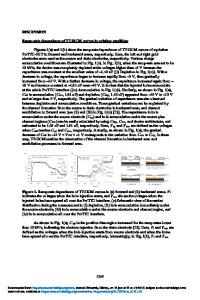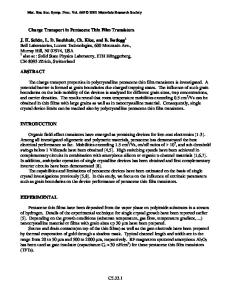Optimizing Pentacene Growth in Low-Voltage Organic Thin-Film Transistors Prepared by Dry Fabrication Techniques
- PDF / 729,773 Bytes
- 6 Pages / 612 x 792 pts (letter) Page_size
- 54 Downloads / 342 Views
Optimizing Pentacene Growth in Low-Voltage Organic Thin-Film Transistors Prepared by Dry Fabrication Techniques S. Gupta1, K. C. Chinnam1, M. Zelzer2, R. Ulijn2, and H. Gleskova1 1 Department of Electronic and Electrical Engineering, 2 Department of Pure and Applied Chemistry, University of Strathclyde, Glasgow, United Kingdom. ABSTRACT We have studied the effect of pentacene purity and evaporation rate on low-voltage organic thin-film transistors (OTFTs) prepared solely by dry fabrication techniques. The maximum field-effect mobility of 0.07 cm2/Vs was achieved for the highest pentacene evaporation rate of 0.32 Å/s and four-time purified pentacene. Four-time purified pentacene also led to the lowest threshold voltage of -1.1 V and inverse subthreshold slope of ~100 mV/decade. In addition, pentacene surface was imaged using atomic force microscopy, and the transistor channel and contact resistances for various pentacene evaporation rates were extracted and compared to field-effect mobilities. INTRODUCTION To turn organic electronic circuits into viable technology platform, transistors require high field-effect mobility and low operating voltage. In addition, technology that can be adapted to roll-to-roll processing is desirable. Here, dry vacuum technologies provide an alternative path to wet printing of organic devices. Organic thin-film transistors (OTFTs) have been demonstrated in display drivers [1], opamps [2], and complementary inverters [3]. These circuits take advantage of low processing temperature typically below 180°C which allows their fabrication on a wide range of plastic substrates. To date, several groups have achieved low voltage OTFTs with high-k aluminium oxide (AlOx) and a self-assembled monolayer (SAM) based on phosphonic acids [4–7]. Our gate dielectric consists of thin AlOx and n-octyl phosphonic acid. In contrast to previous research, AlOx is prepared by UV/ozone oxidation of Al and alkyl-phosphonic acid is vacuum deposited. Pentacene is the most studied p-type organic semiconductor. Jurchescu et al. [8] showed that impurities and defect states in pentacene lead to lower field-effect mobility. In addition, OTFT performance is dependent on the dielectric-semiconductor interface which is affected by preparation of gate dielectric [9–11], the growth of pentacene, and the channel thickness [12]. In this paper, we studied the effect of pentacene evaporation rate and purity on the performance of fully-dry, low-voltage OTFTs with total thickness of gate dielectric of ~ 20 nm. EXPERIMENT All p-channel transistors have a bottom-gate, top source-drain contact structure as shown in figure 1. The TFTs were fabricated on Eagle 2000 glass in a Mini-Spectros vacuum deposition system (Kurt J. Lesker). Firstly, a 30-nm-thick Al gate line was thermally evaporated at a rate of 1 Å/s. Part of the gate electrode (away from the transistor island) was capped with 10-nm-thick gold to prevent its oxidation. To convert the surface of Al gate line into thin AlOx, one hour
UV/ozone treatment was performed in UVOCS UV/
Data Loading...










